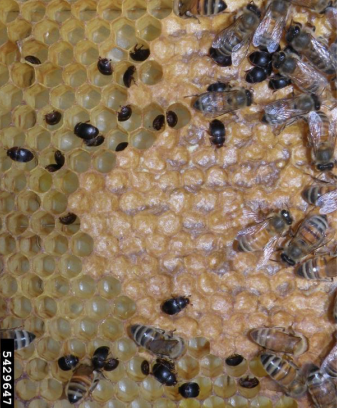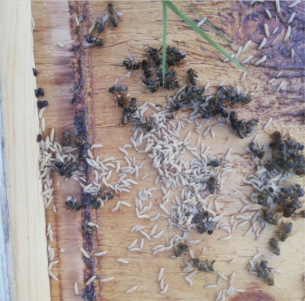Aethina tumida
Authors: Dr. Keith Delaplane, Dr. Lewis J. Bartlett, & Jennifer Berry, Entomologists, University of Georgia, 2022
Description
Immature stages: Though they occupy the same hives, small hive beetle eggs are smaller than honey bee eggs, often laid in disorganized clumps in crevices of hives or in suitable food. Larvae are elongated, whitish grubs with rows of small spines along their backs. Newly hatched larvae are about 1 mm long, but eventually grow to approximately 1 cm. Pupae are whitish brown.
Adult stages: Adults are broad, flattened beetles about 5.7 mm long, 3.2 mm wide and dark brown to nearly black in color. Adults are red just after pupation and soon thereafter turn black. Adult antenna appear clavate, or club-shaped.


Biology
Life cycle: Beetle larvae pupate in the soil outside of beehives. The small hive beetle requires 38-81 days to develop from egg to adult, and five generations per year are possible. Larvae grow rapidly under ideal conditions, reaching full size in less than 14 days, and can be easily visually identified within 3-4 days of hatching in the field.
Distribution: Small hive beetles, or SHB, are native to southern Africa. The first record of this beetle in the western hemisphere was determined from a commercial apiary in Florida in May 1998. Beetle specimens were found from bee hives near Atlanta, Georgia in June 1998 and confirmed as A. tumida on July 13, 1998.
Damage
SHB are not considered a major pest in most of their native range Africa, but it causes severe damage inin Southeastern U.S. apiaries. Beetle larvae tunnel through hives, killing bees and ruining combs. Larvae can heavily damage delicate, newly drawn-out comb; however, old sturdy comb can withstand moderate infestation. Bees are known to abandon combs and entire colonies once they’re infested. Beetles defecate in honey and cause it to ferment, producing a ‘slime,’ and contaminated honey is no longer marketable and is rejected by the bees within infested hives.
Diagnosis
The majority of colonies in the southeast will contain identifiable adult SHB. This alone is not cause for concern, although large numbers of adult beetles may indicate likelihood of a future infestation. Larval infestation is easy to spot; frames will show evidence of the ‘sliming’ caused by the beetles, initially appearing a shiny, sticky sheen over frames and capped honey. This may be especially apparent under protein patties provided to colonies. Young larvae may be visible in capped honey. The smell of fermenting honey may also alert beekeepers to infestation. Destruction of comb and the presence of large larvae in the colony typically indicate a severe infestation and require the transplantation of the bees into a new hive in order to treat or destroy infested frames.
SHB larvae can be differentiated from wax moth larvae due to the fact that they are significantly smaller in size. SHB larvae also have legs on their frontal sections that wax moths do not. If webbing is present in the colony, it is indicative of moths, whereas sliming in the colony points to SHB.
Management
If A. tumida is suspected or detected, here are some things to keep in mind:
- Be clean around the honey house. Do not leave filled supers standing long before extraction. Do not leave
cappings exposed for long periods. Beetles can build up rapidly in stored honey, especially away from
protective bees. - Do not stack or store infested supers onto strong colonies.
- Be aware that supering colonies, making splits, exchanging combs, or use of Porter bee escapes can spread
the beetles or provide room for beetles to become established away from the cluster of protective bees. - Feeding of supplementary protein patties to colonies can cause severe infestation by providing a protected
environment for SHB to lay eggs in and larvae to grow. - Monitor colonies for hygienic behavior. Check to see if they have the ability to actively rid themselves of both larval and adult A.
tumida. Propagate those queen lines found to be beetle-resistant. - Experiment with trapping or cultural control measures.
- Moving colonies may be advisable to keep a beetle population from building up in any particular apiary.
The ability of beetles to complete development may vary according to different soil conditions and beekeepers
may find some locations naturally less prone to beetle infestation, especially drier bare soils in full sunlight.
Impermeable (e.g. concrete, asphalt) surfaces will prevent SHB pupation. Fire ants may be a beneficial insect in
this context if they are found to prey on pupating beetles. - Commercial traps are available to place in the colony, usually filled with vegetable oil or soap water. Traps
are built with apertures large enough for SHB adults to enter but small enough to keep honey bees out; hygienic
bees will chase SHB adults into these traps where the beetles die by drowning.
- Moving colonies may be advisable to keep a beetle population from building up in any particular apiary.
- Bees will normally not clean up equipment or supers full of beetle-fermented honey. However, bees may
finish the job if the beekeeper first washes out as much honey as possible with a high-pressure water hose. - Treat soil in front of affected hives with predatory soil nematodes, Steinernema riobrave or Heterorhabditis
indica. These can either be purchased from suppliers or maintained by beekeepers themselves according to
available protocols. If possible, inspect the nematodes under a microscope for
movement to ensure they are alive at the point of deployment around colonies. - Certain soil drenches to kill SHB are currently available, but must be used with extreme caution as the
insecticides currently licensed for use are highly toxic to bees. - Few in-hive deployable treatments labelled for SHB control show consistent effective control. Bee-safe
insecticides which can target SHB are currently in development, and beekeepers should check for recently
labelled products in the future.
